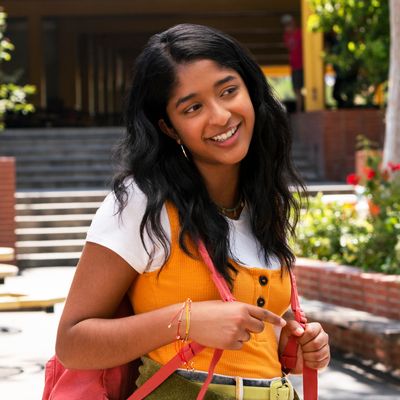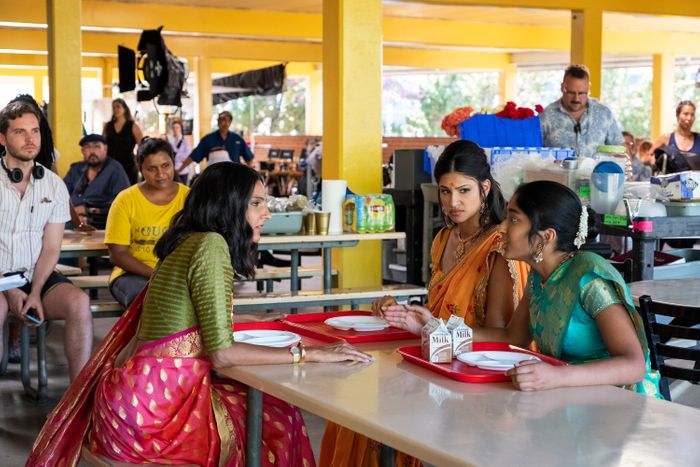
In Never Have I Ever, the new Netflix show co-created by Mindy Kaling, Devi Vishwakumar is a straight-A student who plays the harp, is an ace at Model U.N., and dreams of going to Princeton University. Her two best friends are obsessed with robotics and drama club. She hasn’t dated anybody, much less had her first kiss. She fulfills all the expected TV tropes of a nerd.
Almost all of them. After declaring in the first episode that she and her best friends will get boyfriends for their sophomore year, Devi confidently waltzes up to the most popular boy in school — the unreasonably handsome Paxton Hall-Yoshida (Darren Barnet) — and asks him to have sex. Upending rom-com logic, he nonchalantly says he’s down; Devi says she’ll circle back about it and shakes his hand.
Talking to newcomer Maitreyi Ramakrishnan, the 18-year-old star of Never Have I Ever, it’s easy to understand how Devi came to life onscreen as a nerd with a rock-solid sense of self-worth. Ramakrishnan’s path to a leading role on a Netflix show is about as unlikely as it gets — her last acting gig was playing Velma Kelly in her high school’s production of Chicago back in Ontario — but she doesn’t pretend to be surprised that she nailed it. “I know I’m a really confident person, and it takes a lot to make me nervous,” she says. “I couldn’t even say a moment in my life where I feel truly embarrassed.”
Never Have I Ever began as a pitch to Kaling from a Netflix executive, Brooke Kessler, who read both of Kaling’s books and loved the parts about her high-school years. With a straight-to-series order in hand, Kaling recruited her friend Lang Fisher, a veteran of The Mindy Project, who wrote the episode “Mindy Lahiri Is a White Man,” as well as 30 Rock and Brooklyn Nine-Nine, who is a fan of teen shows like Riverdale, Beverly Hills, 90210, and Gossip Girl. “In writing about teens, I wanted someone who was very interested in that and had a lot of experience watching those shows. She jumped at the opportunity,” Kaling said. “From there, I hired a really young, diverse staff and then we all delved into our childhoods. It was like doing a little bit of therapy every day.”
“Mindy and I were both sort of nerds in high school, but we had these giant personalities, so we created this character to have confidence and a big personality,” Fisher said. “Each episode is supposed to be tailored to something these girls want and the dreams of having a normal teenage experience.”
Unlike so many other teen characters, especially South Asian ones portrayed onscreen, Devi isn’t meek. When she announces to her friends that they’re all getting boyfriends, they don’t question the plausibility of her plan; they just do it. Even when the show tips into the dramatic and emotional — especially as Devi works with a therapist (Niecy Nash) to grieve her beloved father, who died suddenly the previous school year — it doesn’t derail her.
The casting search for Devi was intense: In April 2019, Kaling put out an open call for auditions and got more than 15,000 submissions. It was a lot, she admits, but she considered it a necessity to find the right actor. “There are obviously way more young Desi actors than there were ten to 15 years ago, but it’s a much harder search than if we were trying to find a white lead,” she said. Ramakrishnan, who has deferred but will study acting at York University, only responded to the casting call because it was a good excuse to hang out with a friend who wanted to audition; she had to Google what a “self-tape” was and then figure out how to work her mom’s camera. When the producers called to invite her to Los Angeles for a screen test, she didn’t even pick up, thinking it was spam. (Don’t worry, they emailed her.)
“She’s so comfortable in her own skin, and she just strikes you as not timid at all,” Kaling said of Ramakrishnan, recalling the “endless high fives” she gave to casting directors during auditions. “You learn so much in casting. The kind of chitchat you make with the actors before you start rolling is almost more informative than the audition itself. And she’s a big fan of The Office, and the way she was talking to us was not like a scared, deferential foreign teenager. She was talking to us like another fan of TV, who happened to be 18 years younger than us. It was kind of a no-brainer.”
After Never Have I Ever found its star, the finer aspects of Devi’s character took shape. Kaling says the young actor added a “really informal and comfortable” energy to the role, which the writers tapped into as they finessed the scripts. She also weighed in with her own expertise: When Kaling wasn’t sold on a TikTok cold open in one episode, where Devi and her friends try to make a thirst trap for her crush, she deferred to Ramakrishnan and Fisher and it was ultimately filmed (the scene is a delight). Even the script was open to real-time tweaks. “They created such an environment where I never felt embarrassed to ask questions, and I never felt like I couldn’t challenge somebody’s idea,” Ramakrishnan said. An early moment when Devi says, “What’s poppin’?” to God wasn’t originally written in the script. “That was Lang and Mindy constantly listening to me talk to my other cast members, and I always say, What’s poppin’? That’s my good old Toronto slang with my friends.”
The show is set in Sherman Oaks, California, and the casting choices reflect the fact that a suburb of Los Angeles is diverse: Devi’s two closest girlfriends, Eleanor (Ramona Young) and Fabiola (Lee Rodriguez), are Chinese-American and black. The object of her desires, Paxton, was rewritten as a half-Japanese character after Kaling and Fisher heard the actor cast to play him, Darren Barnet, speaking Japanese on the set with an assistant director. The boyfriend of her annoyingly beautiful and intelligent cousin Kamala (Richa Moorjani) is Asian-American. Kaling and the writing staff — which includes several young Indian writers — drew from their own lives to highlight the varied textures of the Indian-American experience. “There are some things that I pulled straight from my childhood that I wanted to see, like blessing my textbooks at the beginning of the school year and praying to a shrine at home,” Kaling said. One of the show’s writers, Akshara Sekar, talked about how her family blessed her first car; in the show, Devi’s father had his scooter blessed to allay his wife’s safety concerns. “We got all these great stories from people, but I had the added benefit of feeling like I was normal, because I had never had someone else normalize these experiences for me,” Kaling said.
It all hangs together due to Ramakrishnan, who has the sort of natural charisma that makes Devi, a Desi-American cool nerd who isn’t shy with her crushes, feel immediately lived-in. She’s got a “California energy,” as Kaling put it, that makes everything about the show click into place.
“I feel like a lot of people think, You’re so lucky this happened to you. They make it seem like I won the lottery because I just bought a ticket and I submitted it. But the thing is I didn’t just win the lottery; I earned the worth of the lottery,” Ramakrishnan said. “That’s the difference.”


